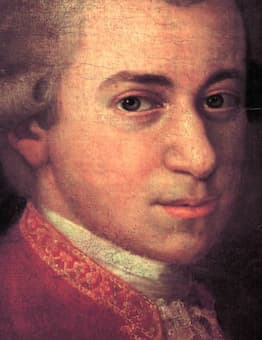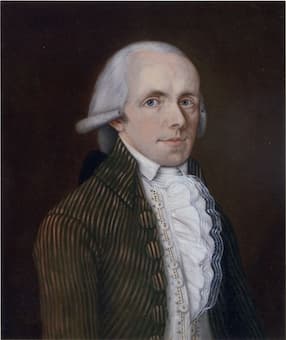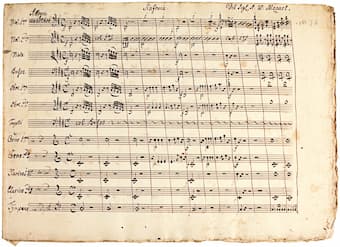
Wolfgang Amadeus Mozart
On 22 July 1776 two of the most powerful Salzburg families joined for the wedding of Elisabeth Haffner and Franz Xaver Späth. The bride’s father, Sigmund Haffner had married the heiress of an important trading post. Sigmund Haffner worked in Salzburg as a wholesaler and he was also active in the financial sector. In 1768 he was elected mayor of Salzburg and held office until his death in 1772. Haffner was “among the best known and most respected in all European and overseas trading ports.” In fact, he still has a street in the Salzburg’s old town named after him.
Wolfgang Amadeus Mozart: Serenade No. 7 in D Major, K. 250 “Haffner” – I. Allegro maestoso (Lucy van Dael, violin; Orchestra of the 18th Century; Frans Brüggen, cond.)
Sigmund Haffner junior was only 15 years of age and suffered from tuberculosis when his father died, but he inherited his father’s fortune amounting to around 70,000 guilders. The flourishing business was taken over by his brother in law Anton Triendl, and Sigmund continued to receive a share of the profits. Sigmund junior made generous donations to orphanages, welfare institutions, hospitals, monasteries, and schools for the poor. For his efforts, Sigmund Haffner was raised to imperial nobility with the title “Edler von Innbachhausen” on 29 July 1782.
Wolfgang Amadeus Mozart: Serenade No. 7 in D Major, K. 250 “Haffner” – II. Andante (Lucy van Dael, violin; Orchestra of the 18th Century; Frans Brüggen, cond.)

Sigmund Haffner Junior
As is known from the Mozart letters, Sigmund Haffner junior was acquainted with the Mozart family. Sigmund’s unconventional lifestyle—he was gay—did not sit well with Leopold Mozart, who wrote to his wife and son on 3 May 1778. “Now another amazing folly; a fruit of poor upbringing and the sad consequence of too much freedom that has been given to Sigmund Haffner since he was here. He was always allowed to live alone with his stable boy in his house in Loreto, without bothering about his performance. Now he will buy Seeburg Castle, which belonged to Count Ernst Lodron and then to his cook, a hideous person with a skinny, big-eyed, completely ape-like face.”
Wolfgang Amadeus Mozart: Serenade No. 7 in D Major, K. 250 “Haffner” – III. Minuet (Lucy van Dael, violin; Orchestra of the 18th Century; Frans Brüggen, cond.)
In the event, Sigmund Haffner junior was in charge of organizing the wedding of his sister Marie Elisabeth to the merchant Franz Xaver Späth. Franz Xaver Späth junior had taken over the trading post, specializing in forwarding and wholesale, set up by his father Franz Xaver Späth senior. The company subsequently established a branch office in Verona, and Späth also sold lottery tickets in his trading office. In addition, he was involved with placing large-scale advertisements in Salzburg newspapers. Without doubt, the marriage of Marie Elisabeth Haffner and Franz Xaver Späth would establish a long-lasting trading emporium.
Wolfgang Amadeus Mozart: Serenade No. 7 in D Major, K. 250 “Haffner” – IV. Rondo: Allegro (Lucy van Dael, violin; Orchestra of the 18th Century; Frans Brüggen, cond.)

Old Town Salzburg across the Salzach river
Sigmund Haffner and Wolfgang Amadeus Mozart had been friends since childhood. As such, Haffner commissioned from Mozart a serenade for the eve before the wedding, to be performed in the garden house. Haffner was essentially looking for party music for the opulent festivities. And Mozart responded with an eight-movement Serenade in D major, “a work of unprecedented scope and sophistication in a genre that most composers of the day treated as disposable background music.” The “Haffner” Serenade premiered on 21 July 1776, with Mozart likely conducting and playing the solo violin part himself.
Wolfgang Amadeus Mozart: Serenade No. 7 in D Major, K. 250 “Haffner” – V. Minuet galante (Lucy van Dael, violin; Orchestra of the 18th Century; Frans Brüggen, cond.)
Mozart clearly understood that his “Haffner” Serenade was to be performed during a lavish garden party. He also understood that his composition would function as background music, and he dutifully emphasized a light musical texture, charming melodies and simplicity of form. This apparent stylistic and musical simplicity and the fact that these pieces had to compete against “a clatter of dishes and chattering guests,” however, stands in clear contrast to the fact that Mozart took these compositions very seriously. It is scored for pairs of oboes alternating with flutes, bassoons, horns, trumpets and a string section of first and second violin, first and second viola and double bass, the last usually doubled by the cello.
Wolfgang Amadeus Mozart: Serenade No. 7 in D Major, K. 250 “Haffner” – VI. Andante (Lucy van Dael, violin; Orchestra of the 18th Century; Frans Brüggen, cond.)

Sigmund Haffner Senior
The opening movement has a celebratory, almost regal character appropriate for its original function. However, Mozart included a tense development sequence featuring unstable dissonances and minor chords. Fortunately, when the main theme returns all the disturbances are quickly forgotten. The following three movements feature a solo violin, “essentially creating a small concerto within the larger form of the serenade.” The “Andante” weaves trills and arpeggios into gently flowing arioso melodies. The orchestra takes the lead in the “Minuet,” with the soloist making his return in the contrasting trio. A vibrant “Rondo” concludes the violin showcase, and gives way to an additional minuet movement and a rousing Allegro finale.
Wolfgang Amadeus Mozart: Serenade No. 7 in D Major, K. 250 “Haffner” – VII. Minuet (Lucy van Dael, violin; Orchestra of the 18th Century; Frans Brüggen, cond.)

Mozart’s Symphony in D arranged from the “Haffner” Serenade
Mozart and his father Leopold quickly realized that Wolfgang had composed a work worthy of multiple uses. As such, they pressed five movements without solo violin into a symphony in D major, only adding a part for timpani. That particular symphony does not carry a Köchel number. This symphony should not be confused with the later “Haffner” Symphony No. 35, K. 385, which was specifically composed in July and August of 1782 for his friend Sigmund Haffner junior, on the occasion of his elevation to royalty. It is also based on a serenade, but a completely different work from the one sounded for the Haffner and Späth wedding.
For more of the best in classical music, sign up for our E-Newsletter
Wolfgang Amadeus Mozart: Serenade No. 7 in D Major, K. 250 “Haffner” – VIII. Adagio – Allegro assai (Lucy van Dael, violin; Orchestra of the 18th Century; Frans Brüggen, cond.)
